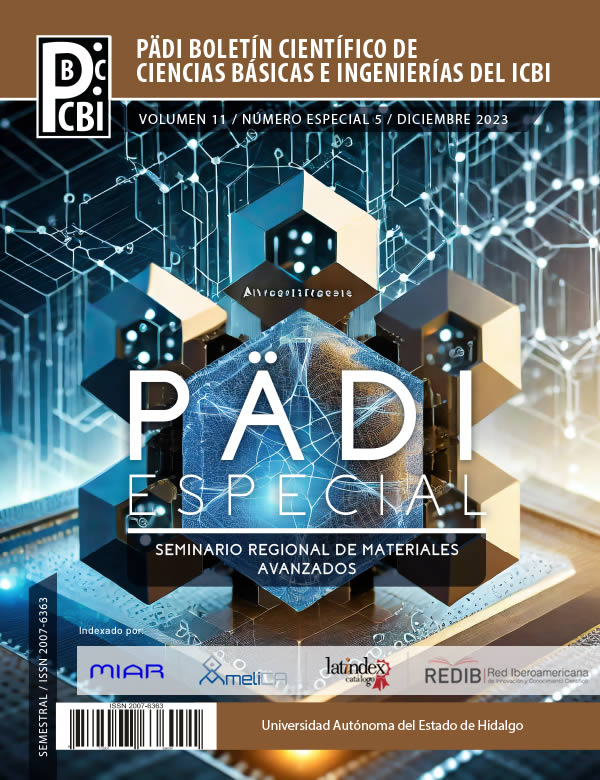Generation of ZnCu nanoparticles from Cu-Zn-Al hydrotalcite-type
Abstract
The emission control of greenhouse gases is taking great scientific relevance today due to climate change. The transformation of CO2 to CH3OH using Cu-Zn/alumina catalysts is a solution to CO2 emission mitigation. A technological and scientific research priority. CuZn dispersion on Al2O3 catalytic supports needs improvement. Therefore, through calcination and reduction processes, a large dispersion of Cu and CuZn metallic nanoparticles with a size of around 5 nm was achieved on an Al-O surface using hydrotalcite clay. A material with great capacity to accept Cu+2 and Zn+2 into its structure. The hexagonal morphology of the hydrotalcite platelets remained unchanged, as did the chemical composition. Therefore, Cu-Zn-Al catalysts with three metallic charges of Cu and Zn were obtained, ready to be evaluated in the reaction of CO2 to CH3OH.
Downloads
References
Antonoglou, O., Founta, E., Karagkounis, V., Pavlidou, E., Litsardakis, G., Mourdikoudis, S., Thanh, N.T.K., Dendrinou-Samara, C., (2019). Structure differentiation of hydrophilic brass nanoparticles using a polyol toolbox. Front. Chem. 7, 817. DOI: 10.3389/fchem.2019.00817
Ectors, D., Goetz-Neunhoeffer, F., Neubauer, J., (2015). A generalized geometric approach to anisotropic peak broadening due to domain morphology. J. Appl. Crystallogr. 48, 189. https://doi.org/10.1107/S1600576714026557
Fragoso-Montes de Oca, A.A., Hernandez-Cortez, J.G., Angeles-Chavez, C., Valente Jaime S., Toledo-Antonio, J.A., (2022). Influence of hydrotalcite/rosasite precursors over Cu/Zn/Al mixed oxides on ethanol dehydrogenation. Mater. Chem. Phys. 291, 126659. DOI: 10.1016/j.matchemphys.2022.126659
Gawande, M.B., Goswami, A., Felpin, F-X., Asefa, T., Huang, X., Silva, R., Zou, X., Zboril, R., Varma, R.S., (2016). Cu and Cu-based nanoparticles: synthesis and applications in catalysis. Chem. Rev. 116, 3722. DOI: 10.1021/acs.chemrev.5b00482
Guzmán, H., Roldán, D., Sacco, A., Castellino, M., Fontana, M., Russo, N., Hernández, S., (2021). CuZnAl-Oxide nanopyramidal mesoporous materials for the electrocatalytic CO2 Reduction to syngas: tuning of H2/CO ratio. Nanomaterials. 11, 3052. https://doi.org/10.3390/nano11113052
Holder, C.F., Schaak, R.E., (2019). Tutorial on powder X‑ray diffraction for characterizing nanoscale materials. ACS Nano. 13, 7359. DOI: 10.1021/acsnano.9b05157
Jiang, X., Nie, X., Guo, X., Song, Ch., Chen, J.G., (2020). Recent advances in carbon dioxide hydrogenation to methanol via heterogeneous catalysis. Chem. Rev. 120, 7984-8034. DOI: 10.1021/acs.chemrev.9b00723
Labuschagné, F.J.W.J., Wiid, A., Venter, H.P., Gevers, B.R., Leuteritz, A., (2018). Green synthesis of hydrotalcite from untreated magnesium oxide and aluminum hydroxide. Green Chem. Lett. Rev. 11, 18–28. DOI:10.1080/17518253.2018.1426791
Prieto, G., Zeevi, J., Friedrich, H., de Jong1, K.P., de Jongh, P.E., (2013). Controlling collective properties of supported metal nanoparticles: towards stable catalysts. Nature. 12, 34. DOI:10.1038/NMAT3471
Rahman, A., (2013). Structure characterization and application of Ni hydrotalcite as environmentally friendly catalyst for reductive amination of benzaldehyde. Int. J. Eng. Sci. Emerg. Technol. 4, 75-82. www.ijeset.com/media/0001/9N8-IJESET0402810
Rodríguez-Ruiz, J., Pájaro-Pallares, A., Meza-Fuentes, E., (2016). Síntesis y caracterización estructural de hidrotalcitas de Cu-Zn-Al. Rev. Colomb. Quím. 45, 33. https://dx.doi.org/10.15446/rev.colomb.quím.v45n3.61381
Copyright (c) 2023 Andrés Arturo Fragoso-Montes de Oca, Carlos Angeles-Chavez, María Antonia Cortés-Jácome, José Antonio Toledo-Antonio, Jaime Sánchez-Valente

This work is licensed under a Creative Commons Attribution-NonCommercial-NoDerivatives 4.0 International License.













